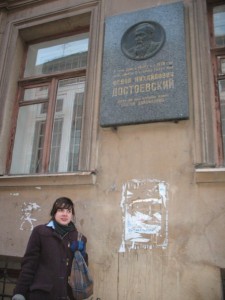 I first learned about the Museum of Innocence some time in 2009, when I had just finished the only real novel I brought with me to Siberia, where I was living at the time. The only English-language choices at the local bookstores consisted of a lot of Sherlock Holmes and James Fennimore Cooper. I was book-thirsty, so maybe it was like listening to someone describe a roast chicken when you are very hungry — it sounds more succulent and delicious than any roast chicken ever is. But at any rate, I managed to get a copy, and I read it voraciously in my cold little kitchen.
I first learned about the Museum of Innocence some time in 2009, when I had just finished the only real novel I brought with me to Siberia, where I was living at the time. The only English-language choices at the local bookstores consisted of a lot of Sherlock Holmes and James Fennimore Cooper. I was book-thirsty, so maybe it was like listening to someone describe a roast chicken when you are very hungry — it sounds more succulent and delicious than any roast chicken ever is. But at any rate, I managed to get a copy, and I read it voraciously in my cold little kitchen.
It was indeed a beautiful novel, but the reason that it lived up to my book-starved imaginings has more to do with the unusual way Pamuk has woven the novel together with the physical world.
From the earliest moments of the novel, protagonist Kemal begins collecting objects connected to his affair with Füsun, the woman he loves unceasingly for decades, even after she dies. After their physical relationship ends permanently, he continues to collect. When she dies, he sets about creating a museum: the Museum of Innocence, which is a real place, located in the real house on the real street in the real Istanbul neighborhood where fictional Füsun lived with her family. It opened earlier this year to much fanfare, four years after the publishing of Pamuk’s novel in Turkish.
I have always loved house museums, the musty old homes of dead writers and artists and revolutionaries. But I am never sure what it is exactly that makes Chekhov’s former Moscow apartment, for example, so entrancing. I am not interested, really, in his bed, or his rug, or the pen that he wrote with. But I like being there, in the space that he occupied. I like the way the old lady caretakers of Chekhov’s dusty belongings talk about “Anton Pal’ich” as though he was their nephew, and they are taking care of him and not just the objects he left behind before they were born.
Dostoevsky’s apartment in St. Petersburg is almost completely empty, but the introductory text lets visitors know that it was here that he wrote a sizeable chunk of The Brothers Karamazov, and suddenly the space matters. Wandering around Tolstoy’s 4,000 acre estate, Yasnaya Polyana, it made sense to me that so many important moments in Tolstoy’s novels happen when someone is walking in the woods alone.
But what do I really learn from these places? Swimming in a sea of dreamy, nostalgic hero-worship, what insight do I actually find on the writer or the writing?
Maybe the answer is not in the aura, but in the stuff itself: the pens and blankets and desks and hardwood floors.
In an essay on the museum in the London Review of Books that gives more insight on the project in the context of literature than I will ever be able to, Elif Batuman writes how the stuff of a novel has the quality of being indistinguishable from the same mass-produced stuff existing in the physical world:
“But physical things… have a certain truth. Like Orthodox icons, they are ‘images not made by hands’: symbols that are also somehow identical to the things they represent.”
Batuman continues:
“All those saltshakers and cigarettes, manmade yet inhuman, coming and going in waves, stand for the rules we live by: in the case of The Museum of Innocence, sexual ethics. That’s the mass-produced object that we’re all conditioned by.”
There is some alchemy occurring here, but it isn’t just the fact of that space, it is the specific objects the space contains, the inarguable, shared reality that shapes the stories.
In the novel the Museum of Innocence, Kemal says at one point, “Real museums are places where time is transformed into space.”
He extrapolates later, “Visitors to my Museum of Innocence must compel themselves, therefore, to view all objects displayed therein… not as real things in the present moment but as my memories”
The two entities, museum and novel, are both part of a world that once existed and does not exist anymore—Istanbul in the 1970s. They fit together and extend beyond one another, and somehow magnify in each other the things that are most magical about both novels and museums.
This post may contain affiliate links.








